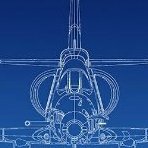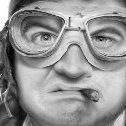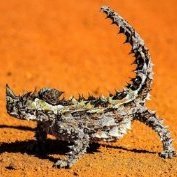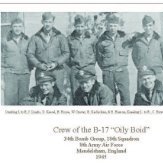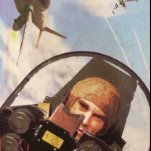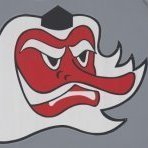-
Posts
3,244 -
Joined
-
Last visited
-
Days Won
272
Reputation Activity
-
 Thunnus got a reaction from Greg W in 1/32 Hasegawa Ki-61 Tei Hien
Thunnus got a reaction from Greg W in 1/32 Hasegawa Ki-61 Tei Hien
This one is not dead but I keep jumping to other projects!
I decided to start the painting process by putting on the hinomarus on the wing bottom. Normally, I put the markings on after the camo painting but in order to protect the natural metal finish here, I thought I'd do some reverse masking. First, a rough base coat of Tamiya White. It is purposefully uneven to serve as a pre-shade layer.
After the white, Mr Color C385 IJN Red is sprayed on.
Masks cut from decal scans are placed over the red. Due to the raised feature on the aileron, the mask was snipped and replaced with a more form-fitting mask made from Tamiya tape.
Mr Primer Surfacer 1000 was used to remove the excess red.
The fabric colored ailerons were then given a mottle pre-shade and painted with a grayish green shade (Tamiya XF-76).
The ailerons will be masked off and I can start painting the NMF bottom.
-
 Thunnus got a reaction from mywifehatesmodels in Infinity Models 1/32 Aichi D3A1 Type 99
Thunnus got a reaction from mywifehatesmodels in Infinity Models 1/32 Aichi D3A1 Type 99
Thanks guys! The model is about 12 inches (30.5cm) long with an 18 inch (45.7cm) wingspan.
Just some additional views of the starboard side to show the modified surface texture that resulted from the removal of the oil-canning.
-
 Thunnus got a reaction from Sasha As in Infinity Models 1/32 Aichi D3A1 Type 99
Thunnus got a reaction from Sasha As in Infinity Models 1/32 Aichi D3A1 Type 99
Thanks guys!
Thanks Mike! Screws makes sense since I'm guessing these are access panels for the cowl guns? And raised because one panel is used to cover two openings?
I was able to secure a copy of this out-of-print book for a real good price ($20 shipped) from the Arawasi blog site so I'm taking my time on things until it gets here.
The wheels have been painted and weathered.
But only a sliver of them will be visible once they are mounted within the wheel spats.
When gluing the spats together, I left the wheels rotatable so that I can orient the flat spots on the tires later. The prominent glue seam will get sanded and puttied.
In order to get a more positive fit onto the wing bottoms, I added some mounting posts for the landing gear legs. This is taking a page from Alex's build but in a slightly different form.
I heeded Alex's warning about the thickness of the control surface parts and decided to thin them before gluing them together. For this, I use a section of sanding paper taped onto a sheet of glass (from a photo frame). For this type of work, I use a coarser grain of sandpaper than I normally work with such as #320 or #220 (3M)
The insides of the elevator pieces look flat to the naked eye.
But a few swipes on the sanding block show that they aren't perfectly flat. The dark areas indicate surfaces that are lower than the surrounding areas. The dark areas along the edge will result in gaps which are difficult to correct.
So I keep sanding until the all of the dark areas are gone.
The parts secured with just tape and finger pressure reveal the lack of gaps along the edge, which is the desired result. The elevators can now be glued together.
At this point, I decided to rough fit the major components together by tape to check overall fit. There may be some significant gaps that I'll need to pay attention to. Particularly along the leading edge of the vertical stabilizer fillet and at the wing roots. But overall, fit looks pretty good.
This is a LARGE aircraft with heckuva wingspan. It will NOT fit into my Ikea Detolf display case.
-
 Thunnus got a reaction from Victor K2 in 1/32 Hasegawa Ki-61 Tei Hien
Thunnus got a reaction from Victor K2 in 1/32 Hasegawa Ki-61 Tei Hien
This one is not dead but I keep jumping to other projects!
I decided to start the painting process by putting on the hinomarus on the wing bottom. Normally, I put the markings on after the camo painting but in order to protect the natural metal finish here, I thought I'd do some reverse masking. First, a rough base coat of Tamiya White. It is purposefully uneven to serve as a pre-shade layer.
After the white, Mr Color C385 IJN Red is sprayed on.
Masks cut from decal scans are placed over the red. Due to the raised feature on the aileron, the mask was snipped and replaced with a more form-fitting mask made from Tamiya tape.
Mr Primer Surfacer 1000 was used to remove the excess red.
The fabric colored ailerons were then given a mottle pre-shade and painted with a grayish green shade (Tamiya XF-76).
The ailerons will be masked off and I can start painting the NMF bottom.
-
 Thunnus got a reaction from Greg W in Infinity Models 1/32 Aichi D3A1 Type 99
Thunnus got a reaction from Greg W in Infinity Models 1/32 Aichi D3A1 Type 99
Thanks guys! The model is about 12 inches (30.5cm) long with an 18 inch (45.7cm) wingspan.
Just some additional views of the starboard side to show the modified surface texture that resulted from the removal of the oil-canning.
-
 Thunnus got a reaction from Greg W in Infinity Models 1/32 Aichi D3A1 Type 99
Thunnus got a reaction from Greg W in Infinity Models 1/32 Aichi D3A1 Type 99
Thanks guys!
Thanks Mike! Screws makes sense since I'm guessing these are access panels for the cowl guns? And raised because one panel is used to cover two openings?
I was able to secure a copy of this out-of-print book for a real good price ($20 shipped) from the Arawasi blog site so I'm taking my time on things until it gets here.
The wheels have been painted and weathered.
But only a sliver of them will be visible once they are mounted within the wheel spats.
When gluing the spats together, I left the wheels rotatable so that I can orient the flat spots on the tires later. The prominent glue seam will get sanded and puttied.
In order to get a more positive fit onto the wing bottoms, I added some mounting posts for the landing gear legs. This is taking a page from Alex's build but in a slightly different form.
I heeded Alex's warning about the thickness of the control surface parts and decided to thin them before gluing them together. For this, I use a section of sanding paper taped onto a sheet of glass (from a photo frame). For this type of work, I use a coarser grain of sandpaper than I normally work with such as #320 or #220 (3M)
The insides of the elevator pieces look flat to the naked eye.
But a few swipes on the sanding block show that they aren't perfectly flat. The dark areas indicate surfaces that are lower than the surrounding areas. The dark areas along the edge will result in gaps which are difficult to correct.
So I keep sanding until the all of the dark areas are gone.
The parts secured with just tape and finger pressure reveal the lack of gaps along the edge, which is the desired result. The elevators can now be glued together.
At this point, I decided to rough fit the major components together by tape to check overall fit. There may be some significant gaps that I'll need to pay attention to. Particularly along the leading edge of the vertical stabilizer fillet and at the wing roots. But overall, fit looks pretty good.
This is a LARGE aircraft with heckuva wingspan. It will NOT fit into my Ikea Detolf display case.
-
 Thunnus got a reaction from Model_Monkey in 1/32 Hasegawa Ki-61 Tei Hien
Thunnus got a reaction from Model_Monkey in 1/32 Hasegawa Ki-61 Tei Hien
This one is not dead but I keep jumping to other projects!
I decided to start the painting process by putting on the hinomarus on the wing bottom. Normally, I put the markings on after the camo painting but in order to protect the natural metal finish here, I thought I'd do some reverse masking. First, a rough base coat of Tamiya White. It is purposefully uneven to serve as a pre-shade layer.
After the white, Mr Color C385 IJN Red is sprayed on.
Masks cut from decal scans are placed over the red. Due to the raised feature on the aileron, the mask was snipped and replaced with a more form-fitting mask made from Tamiya tape.
Mr Primer Surfacer 1000 was used to remove the excess red.
The fabric colored ailerons were then given a mottle pre-shade and painted with a grayish green shade (Tamiya XF-76).
The ailerons will be masked off and I can start painting the NMF bottom.
-
 Thunnus got a reaction from CODY in 1/32 Hasegawa Ki-61 Tei Hien
Thunnus got a reaction from CODY in 1/32 Hasegawa Ki-61 Tei Hien
This one is not dead but I keep jumping to other projects!
I decided to start the painting process by putting on the hinomarus on the wing bottom. Normally, I put the markings on after the camo painting but in order to protect the natural metal finish here, I thought I'd do some reverse masking. First, a rough base coat of Tamiya White. It is purposefully uneven to serve as a pre-shade layer.
After the white, Mr Color C385 IJN Red is sprayed on.
Masks cut from decal scans are placed over the red. Due to the raised feature on the aileron, the mask was snipped and replaced with a more form-fitting mask made from Tamiya tape.
Mr Primer Surfacer 1000 was used to remove the excess red.
The fabric colored ailerons were then given a mottle pre-shade and painted with a grayish green shade (Tamiya XF-76).
The ailerons will be masked off and I can start painting the NMF bottom.
-
 Thunnus got a reaction from JayW in 1/32 Hasegawa Ki-61 Tei Hien
Thunnus got a reaction from JayW in 1/32 Hasegawa Ki-61 Tei Hien
Yes, Jay... shot through an airbrush. Thinned at about 1:1 using Mr. Leveling Thinner.
-
 Thunnus got a reaction from amurray in Infinity Models 1/32 Aichi D3A1 Type 99
Thunnus got a reaction from amurray in Infinity Models 1/32 Aichi D3A1 Type 99
Thanks guys! The model is about 12 inches (30.5cm) long with an 18 inch (45.7cm) wingspan.
Just some additional views of the starboard side to show the modified surface texture that resulted from the removal of the oil-canning.
-
 Thunnus got a reaction from Uncarina in Infinity Models 1/32 Aichi D3A1 Type 99
Thunnus got a reaction from Uncarina in Infinity Models 1/32 Aichi D3A1 Type 99
Thanks guys!
Thanks Mike! Screws makes sense since I'm guessing these are access panels for the cowl guns? And raised because one panel is used to cover two openings?
I was able to secure a copy of this out-of-print book for a real good price ($20 shipped) from the Arawasi blog site so I'm taking my time on things until it gets here.
The wheels have been painted and weathered.
But only a sliver of them will be visible once they are mounted within the wheel spats.
When gluing the spats together, I left the wheels rotatable so that I can orient the flat spots on the tires later. The prominent glue seam will get sanded and puttied.
In order to get a more positive fit onto the wing bottoms, I added some mounting posts for the landing gear legs. This is taking a page from Alex's build but in a slightly different form.
I heeded Alex's warning about the thickness of the control surface parts and decided to thin them before gluing them together. For this, I use a section of sanding paper taped onto a sheet of glass (from a photo frame). For this type of work, I use a coarser grain of sandpaper than I normally work with such as #320 or #220 (3M)
The insides of the elevator pieces look flat to the naked eye.
But a few swipes on the sanding block show that they aren't perfectly flat. The dark areas indicate surfaces that are lower than the surrounding areas. The dark areas along the edge will result in gaps which are difficult to correct.
So I keep sanding until the all of the dark areas are gone.
The parts secured with just tape and finger pressure reveal the lack of gaps along the edge, which is the desired result. The elevators can now be glued together.
At this point, I decided to rough fit the major components together by tape to check overall fit. There may be some significant gaps that I'll need to pay attention to. Particularly along the leading edge of the vertical stabilizer fillet and at the wing roots. But overall, fit looks pretty good.
This is a LARGE aircraft with heckuva wingspan. It will NOT fit into my Ikea Detolf display case.
-
 Thunnus got a reaction from patricksparks in 1/32 Hasegawa Ki-61 Tei Hien
Thunnus got a reaction from patricksparks in 1/32 Hasegawa Ki-61 Tei Hien
This one is not dead but I keep jumping to other projects!
I decided to start the painting process by putting on the hinomarus on the wing bottom. Normally, I put the markings on after the camo painting but in order to protect the natural metal finish here, I thought I'd do some reverse masking. First, a rough base coat of Tamiya White. It is purposefully uneven to serve as a pre-shade layer.
After the white, Mr Color C385 IJN Red is sprayed on.
Masks cut from decal scans are placed over the red. Due to the raised feature on the aileron, the mask was snipped and replaced with a more form-fitting mask made from Tamiya tape.
Mr Primer Surfacer 1000 was used to remove the excess red.
The fabric colored ailerons were then given a mottle pre-shade and painted with a grayish green shade (Tamiya XF-76).
The ailerons will be masked off and I can start painting the NMF bottom.
-
 Thunnus got a reaction from Uncarina in Infinity Models 1/32 Aichi D3A1 Type 99
Thunnus got a reaction from Uncarina in Infinity Models 1/32 Aichi D3A1 Type 99
Thanks guys! The model is about 12 inches (30.5cm) long with an 18 inch (45.7cm) wingspan.
Just some additional views of the starboard side to show the modified surface texture that resulted from the removal of the oil-canning.
-
 Thunnus got a reaction from Fanes in Infinity Models 1/32 Aichi D3A1 Type 99
Thunnus got a reaction from Fanes in Infinity Models 1/32 Aichi D3A1 Type 99
Thanks guys!
Thanks Mike! Screws makes sense since I'm guessing these are access panels for the cowl guns? And raised because one panel is used to cover two openings?
I was able to secure a copy of this out-of-print book for a real good price ($20 shipped) from the Arawasi blog site so I'm taking my time on things until it gets here.
The wheels have been painted and weathered.
But only a sliver of them will be visible once they are mounted within the wheel spats.
When gluing the spats together, I left the wheels rotatable so that I can orient the flat spots on the tires later. The prominent glue seam will get sanded and puttied.
In order to get a more positive fit onto the wing bottoms, I added some mounting posts for the landing gear legs. This is taking a page from Alex's build but in a slightly different form.
I heeded Alex's warning about the thickness of the control surface parts and decided to thin them before gluing them together. For this, I use a section of sanding paper taped onto a sheet of glass (from a photo frame). For this type of work, I use a coarser grain of sandpaper than I normally work with such as #320 or #220 (3M)
The insides of the elevator pieces look flat to the naked eye.
But a few swipes on the sanding block show that they aren't perfectly flat. The dark areas indicate surfaces that are lower than the surrounding areas. The dark areas along the edge will result in gaps which are difficult to correct.
So I keep sanding until the all of the dark areas are gone.
The parts secured with just tape and finger pressure reveal the lack of gaps along the edge, which is the desired result. The elevators can now be glued together.
At this point, I decided to rough fit the major components together by tape to check overall fit. There may be some significant gaps that I'll need to pay attention to. Particularly along the leading edge of the vertical stabilizer fillet and at the wing roots. But overall, fit looks pretty good.
This is a LARGE aircraft with heckuva wingspan. It will NOT fit into my Ikea Detolf display case.
-
 Thunnus got a reaction from Alain Gadbois in 1/32 Hasegawa Ki-61 Tei Hien
Thunnus got a reaction from Alain Gadbois in 1/32 Hasegawa Ki-61 Tei Hien
This one is not dead but I keep jumping to other projects!
I decided to start the painting process by putting on the hinomarus on the wing bottom. Normally, I put the markings on after the camo painting but in order to protect the natural metal finish here, I thought I'd do some reverse masking. First, a rough base coat of Tamiya White. It is purposefully uneven to serve as a pre-shade layer.
After the white, Mr Color C385 IJN Red is sprayed on.
Masks cut from decal scans are placed over the red. Due to the raised feature on the aileron, the mask was snipped and replaced with a more form-fitting mask made from Tamiya tape.
Mr Primer Surfacer 1000 was used to remove the excess red.
The fabric colored ailerons were then given a mottle pre-shade and painted with a grayish green shade (Tamiya XF-76).
The ailerons will be masked off and I can start painting the NMF bottom.
-
 Thunnus got a reaction from Fanes in Infinity Models 1/32 Aichi D3A1 Type 99
Thunnus got a reaction from Fanes in Infinity Models 1/32 Aichi D3A1 Type 99
Thanks guys! The model is about 12 inches (30.5cm) long with an 18 inch (45.7cm) wingspan.
Just some additional views of the starboard side to show the modified surface texture that resulted from the removal of the oil-canning.
-
 Thunnus got a reaction from Scotsman in Infinity Models 1/32 Aichi D3A1 Type 99
Thunnus got a reaction from Scotsman in Infinity Models 1/32 Aichi D3A1 Type 99
Thanks guys! The model is about 12 inches (30.5cm) long with an 18 inch (45.7cm) wingspan.
Just some additional views of the starboard side to show the modified surface texture that resulted from the removal of the oil-canning.
-
 Thunnus got a reaction from Shoggz in 1/32 Hasegawa Ki-61 Tei Hien
Thunnus got a reaction from Shoggz in 1/32 Hasegawa Ki-61 Tei Hien
This one is not dead but I keep jumping to other projects!
I decided to start the painting process by putting on the hinomarus on the wing bottom. Normally, I put the markings on after the camo painting but in order to protect the natural metal finish here, I thought I'd do some reverse masking. First, a rough base coat of Tamiya White. It is purposefully uneven to serve as a pre-shade layer.
After the white, Mr Color C385 IJN Red is sprayed on.
Masks cut from decal scans are placed over the red. Due to the raised feature on the aileron, the mask was snipped and replaced with a more form-fitting mask made from Tamiya tape.
Mr Primer Surfacer 1000 was used to remove the excess red.
The fabric colored ailerons were then given a mottle pre-shade and painted with a grayish green shade (Tamiya XF-76).
The ailerons will be masked off and I can start painting the NMF bottom.
-
 Thunnus got a reaction from Isar 30/07 in 1/32 Hasegawa Ki-61 Tei Hien
Thunnus got a reaction from Isar 30/07 in 1/32 Hasegawa Ki-61 Tei Hien
This one is not dead but I keep jumping to other projects!
I decided to start the painting process by putting on the hinomarus on the wing bottom. Normally, I put the markings on after the camo painting but in order to protect the natural metal finish here, I thought I'd do some reverse masking. First, a rough base coat of Tamiya White. It is purposefully uneven to serve as a pre-shade layer.
After the white, Mr Color C385 IJN Red is sprayed on.
Masks cut from decal scans are placed over the red. Due to the raised feature on the aileron, the mask was snipped and replaced with a more form-fitting mask made from Tamiya tape.
Mr Primer Surfacer 1000 was used to remove the excess red.
The fabric colored ailerons were then given a mottle pre-shade and painted with a grayish green shade (Tamiya XF-76).
The ailerons will be masked off and I can start painting the NMF bottom.
-
 Thunnus got a reaction from Rocat in Infinity Models 1/32 Aichi D3A1 Type 99
Thunnus got a reaction from Rocat in Infinity Models 1/32 Aichi D3A1 Type 99
Thanks guys! The model is about 12 inches (30.5cm) long with an 18 inch (45.7cm) wingspan.
Just some additional views of the starboard side to show the modified surface texture that resulted from the removal of the oil-canning.
-
 Thunnus reacted to dennismcc in Infinity Models 1/32 Aichi D3A1 Type 99
Thunnus reacted to dennismcc in Infinity Models 1/32 Aichi D3A1 Type 99
Very impressive seeing it all assembled, great work as usual.
Cheers
Dennis
-
 Thunnus reacted to scvrobeson in Infinity Models 1/32 Aichi D3A1 Type 99
Thunnus reacted to scvrobeson in Infinity Models 1/32 Aichi D3A1 Type 99
Great progress John! Always enjoy seeing your process. Looks like the fuselage might need a spreader fitted if the cockpit floor doesn't push it out.
What are the measurements on this one?
Matt
-
 Thunnus got a reaction from Kagemusha in Infinity Models 1/32 Aichi D3A1 Type 99
Thunnus got a reaction from Kagemusha in Infinity Models 1/32 Aichi D3A1 Type 99
Thanks guys!
Thanks Mike! Screws makes sense since I'm guessing these are access panels for the cowl guns? And raised because one panel is used to cover two openings?
I was able to secure a copy of this out-of-print book for a real good price ($20 shipped) from the Arawasi blog site so I'm taking my time on things until it gets here.
The wheels have been painted and weathered.
But only a sliver of them will be visible once they are mounted within the wheel spats.
When gluing the spats together, I left the wheels rotatable so that I can orient the flat spots on the tires later. The prominent glue seam will get sanded and puttied.
In order to get a more positive fit onto the wing bottoms, I added some mounting posts for the landing gear legs. This is taking a page from Alex's build but in a slightly different form.
I heeded Alex's warning about the thickness of the control surface parts and decided to thin them before gluing them together. For this, I use a section of sanding paper taped onto a sheet of glass (from a photo frame). For this type of work, I use a coarser grain of sandpaper than I normally work with such as #320 or #220 (3M)
The insides of the elevator pieces look flat to the naked eye.
But a few swipes on the sanding block show that they aren't perfectly flat. The dark areas indicate surfaces that are lower than the surrounding areas. The dark areas along the edge will result in gaps which are difficult to correct.
So I keep sanding until the all of the dark areas are gone.
The parts secured with just tape and finger pressure reveal the lack of gaps along the edge, which is the desired result. The elevators can now be glued together.
At this point, I decided to rough fit the major components together by tape to check overall fit. There may be some significant gaps that I'll need to pay attention to. Particularly along the leading edge of the vertical stabilizer fillet and at the wing roots. But overall, fit looks pretty good.
This is a LARGE aircraft with heckuva wingspan. It will NOT fit into my Ikea Detolf display case.
-
 Thunnus got a reaction from Scotsman in Infinity Models 1/32 Aichi D3A1 Type 99
Thunnus got a reaction from Scotsman in Infinity Models 1/32 Aichi D3A1 Type 99
Thanks guys!
Thanks Mike! Screws makes sense since I'm guessing these are access panels for the cowl guns? And raised because one panel is used to cover two openings?
I was able to secure a copy of this out-of-print book for a real good price ($20 shipped) from the Arawasi blog site so I'm taking my time on things until it gets here.
The wheels have been painted and weathered.
But only a sliver of them will be visible once they are mounted within the wheel spats.
When gluing the spats together, I left the wheels rotatable so that I can orient the flat spots on the tires later. The prominent glue seam will get sanded and puttied.
In order to get a more positive fit onto the wing bottoms, I added some mounting posts for the landing gear legs. This is taking a page from Alex's build but in a slightly different form.
I heeded Alex's warning about the thickness of the control surface parts and decided to thin them before gluing them together. For this, I use a section of sanding paper taped onto a sheet of glass (from a photo frame). For this type of work, I use a coarser grain of sandpaper than I normally work with such as #320 or #220 (3M)
The insides of the elevator pieces look flat to the naked eye.
But a few swipes on the sanding block show that they aren't perfectly flat. The dark areas indicate surfaces that are lower than the surrounding areas. The dark areas along the edge will result in gaps which are difficult to correct.
So I keep sanding until the all of the dark areas are gone.
The parts secured with just tape and finger pressure reveal the lack of gaps along the edge, which is the desired result. The elevators can now be glued together.
At this point, I decided to rough fit the major components together by tape to check overall fit. There may be some significant gaps that I'll need to pay attention to. Particularly along the leading edge of the vertical stabilizer fillet and at the wing roots. But overall, fit looks pretty good.
This is a LARGE aircraft with heckuva wingspan. It will NOT fit into my Ikea Detolf display case.
-
 Thunnus got a reaction from Rocat in Infinity Models 1/32 Aichi D3A1 Type 99
Thunnus got a reaction from Rocat in Infinity Models 1/32 Aichi D3A1 Type 99
Thanks guys!
Thanks Mike! Screws makes sense since I'm guessing these are access panels for the cowl guns? And raised because one panel is used to cover two openings?
I was able to secure a copy of this out-of-print book for a real good price ($20 shipped) from the Arawasi blog site so I'm taking my time on things until it gets here.
The wheels have been painted and weathered.
But only a sliver of them will be visible once they are mounted within the wheel spats.
When gluing the spats together, I left the wheels rotatable so that I can orient the flat spots on the tires later. The prominent glue seam will get sanded and puttied.
In order to get a more positive fit onto the wing bottoms, I added some mounting posts for the landing gear legs. This is taking a page from Alex's build but in a slightly different form.
I heeded Alex's warning about the thickness of the control surface parts and decided to thin them before gluing them together. For this, I use a section of sanding paper taped onto a sheet of glass (from a photo frame). For this type of work, I use a coarser grain of sandpaper than I normally work with such as #320 or #220 (3M)
The insides of the elevator pieces look flat to the naked eye.
But a few swipes on the sanding block show that they aren't perfectly flat. The dark areas indicate surfaces that are lower than the surrounding areas. The dark areas along the edge will result in gaps which are difficult to correct.
So I keep sanding until the all of the dark areas are gone.
The parts secured with just tape and finger pressure reveal the lack of gaps along the edge, which is the desired result. The elevators can now be glued together.
At this point, I decided to rough fit the major components together by tape to check overall fit. There may be some significant gaps that I'll need to pay attention to. Particularly along the leading edge of the vertical stabilizer fillet and at the wing roots. But overall, fit looks pretty good.
This is a LARGE aircraft with heckuva wingspan. It will NOT fit into my Ikea Detolf display case.



